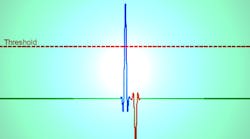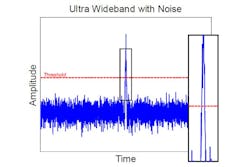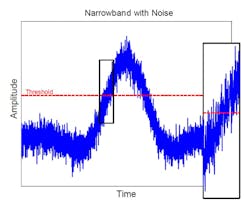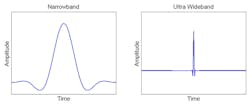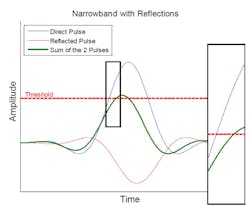More devices being made these days need to track their location as they move around. Though best known in smartphone applications, particularly in terms of GPS and now the onset of indoor location, it’s making its way into a wide variety of other devices—from wireless toys to consumer drones, from keychains that want to be found to shopping carts tracked around a store. Buzzwords used to describe these devices include Internet of Things, wearable-computing smart devices, smart-home devices, connected appliances, and others. The common element among them all is the desire to track their position.
Designers making devices that need to track location face the challenge of selecting the right technology. Is Wi-Fi or Bluetooth best due to their track records in mobile-device deployments? Or do newer radio technologies hold an advantage? What tradeoffs are involved?
Location Tracking Using Bluetooth
Bluetooth-based location tracking has received lots of attention since Apple announced its iBeacon technology. If Apple is using Bluetooth for indoor location (more specifically, Bluetooth Low Energy, or BLE), wouldn’t that be the best approach?
This file type includes high resolution graphics and schematics when applicable.
First, it’s important to distinguish iBeacons and their role, namely proximity detection, from the more general problem of measuring location and distance. Proximity sensing is when a device detects that it’s within range of another device, such as when a phone enters range of a beacon. Detecting proximity doesn’t necessitate measurement of distance; rather, it only requires detecting a steady signal. Some of these systems distinguish being “in range” of a beacon and being “close” to a beacon by distinguishing weak and strong signal strengths. However, this still isn’t the same as measuring precise distance or tracking location.
Some companies have taken BLE to the next step by using BLE signals to measure distance between a phone and a beacon. They measure the signal strength and convert that signal strength to a distance estimate. The problem with such an approach, of course, is that signal strength is a poor indicator of distance. If signal strength is low, does that mean the phone is far from the beacon or that there’s a huge pillar between the beacon and the phone?
One solution to this last problem involves an approach called “fingerprinting.” Beacons, installed in fixed locations, take measurements every few meters to record the signal strengths from each beacon at each spot. These sets of signal strengths are saved in a fingerprint database. Then, if a device wants to determine its location, it can compare the set of currently measurable signal strengths to the fingerprint database, and the closest match is assumed to be close to the current location.
Fingerprinting has many variations that use algorithms with a wide range of sophistication. It’s important to remember, though, that these systems work around Bluetooth’s inability to accurately measure distance—they don’t truly solve the distance-measuring problem.
Location Tracking Using Wi-Fi
Before Apple brought BLE to the forefront in proximity detection, the most common radio signals for indoor-location positioning was Wi-Fi. Today, they’re the most common signals used for indoor-location technologies running on Android phones, often used in conjunction with BLE. Wi-Fi’s main advantage is its prevalence in the majority of public or private places.
The common approach to estimating distance or location with Wi-Fi signals is to measure signal strength, as discussed above for Bluetooth. Signal strength is the most readily available Wi-Fi data on smartphones and mobile devices. But estimating distance by signal strength suffers from the same challenges as described for Bluetooth. Some companies have developed alternative algorithms, attempting to measure distance more precisely using the time of flight (ToF) or time of arrival (ToA) of Wi-Fi signals, but this can’t be done in a straightforward manner using standard Wi-Fi hardware.
Difficulty in measuring precisely when a Wi-Fi or Bluetooth radio signal arrives at its destination is due in part to the inherent structure of narrowband radio waves. As it crosses a given threshold, a narrowband radio wave with typical noise (Fig. 1) demonstrates how difficult it can be to measure precisely. As the signal goes up and down in a SIN-wave-like manner, selecting a threshold to measure becomes hard enough; the tiny perturbations from noise only makes this more difficult to measure consistently. Needless to say, narrowband systems aren’t the easiest to use when trying to achieve consistent direct measurement of signal arrival.
This ratchets up even further in the presence of signal reflections and multi-path effects, which are commonly found in everyday environments. The reflection causes the radio band pulse to reverse itself and partially cancel out the original signal (Fig. 2). This means that interference and multi-path effects will not only weaken the signal, but also damage its integrity. This will likely not damage the data payload, but it will hurt the ability to measure the start and stop of the signal (Fig. 3).
Location Tracking Using Ultra-Wideband
New standards for ultra-wideband (UWB) radio signals have been designed to address this problem. The new IEEE 802.15.4-2011 standard uses radio waves with very short impulse transmissions (Fig. 4). The short bursts of signals, with sharp rises and drops, makes the signals’ starts and stops inherently easier to measure. This means that the distance between two UWB devices can be measured precisely by measuring the time that it takes for a radio wave to pass between the two devices. It delivers much more precise distance measurement than signal-strength estimation.
More importantly, UWB signals maintain their integrity and structure even in the presence of noise and multi-path effects. As shown in Figure 5, the nature of noise doesn’t hurt the distinctiveness of the short burst of signal. Moreover, due to the shortness of the radio pulse, multi-path effects will typically not overlap with the true signal, thus not damaging the integrity and strength of the true signal.
This difference in radio structure means that UWB radio waves can inherently be measured much more precisely, with well-defined start and stop and with little damage by multi-path effects.
In practice, UWB signals are able to effectively measure distance between two devices with 5- to 10-cm accuracy, compared to roughly 5-m accuracy for Wi-Fi and Bluetooth. When implemented in a system of fixed beacons tracking tag locations, the locations can be calculated to within 10-cm accuracy.
Examining The Tradeoffs
The accuracy advantages of UWB are clear: UWB can measure distance and location to an accuracy of 5 to 10 cm, while Wi-Fi, Bluetooth, and other narrowband radio systems can only reach an accuracy of several meters. What are the other tradeoffs between the different systems?
Modern-day UWB systems provide a data rate of 6 to 8 MB/s, which falls between Wi-Fi and Bluetooth. Previous-generation UWB delivered much higher data rates, up to 100 MB/s, but power requirements and distance range made it impractical for use in mobile devices. Though today’s UWB may not be sufficient for streaming HD video, it’s enough for sensor data, security camera streams, instructions, and the like.
UWB consumes significantly less power than Wi-Fi, although Bluetooth 4.0 also uses extremely low power. That, of course, is a key factor for mobile devices and other small electronics in terms of battery life and practical usability.
Obviously, one tradeoff against UWB is that Wi-Fi- and Bluetooth-enabled devices are better able to interact with today’s smartphones and tablets. Nonetheless, some companies are implementing UWB, building devices that use both UWB and either Wi-Fi or Bluetooth to get the best of both worlds.
What’s Next
While smartphones and tablets garner most of the attention these days, electronics design is moving more and more to the next generation of smaller devices, which comprises wearable devices and the Internet of Things. Devices are steadily shrinking, from appliance-sized to pocket- or wristwatch-sized, and correspondingly, power and size requirements are getting increasingly important. At the same time, data-rate requirements are often less significant—smaller devices tend to send and receive sensor data and instructions, not the HD video that typically goes to bigger screens.
Increasingly, designers of wearable and Internet of Things devices also want to be able to precisely track location. Some devices are designed to be found by other devices; some move around (like robots) and need to know where they are so as not to bump into walls; some carry out various actions based on their location (such as turning on a radio when entering a room); some are designed to know how far they are from other devices; and some want to track their locations for other new and innovative reasons. Whatever the reason, UWB technology gives devices the ability to track their locations more precisely than Bluetooth or Wi-Fi, with lower power and size requirements.
This file type includes high resolution graphics and schematics when applicable.
Precise location tracking is also critical for next-generation robot devices. A robot moving through a doorway needs to be sure that it’s going to make it through without bumping and damaging the sides of the door. Meter-level location accuracy simply isn’t good enough for moving through a doorway. The same parameters hold true for the budding market of aerial drones.
Conclusion
For electronics designers that need very precise location measurement, accurate to 5 to10 cm with small size and power requirements, few choices exist on the market beyond modern UWB systems. UWB is currently at a disadvantage of not being handled by today’s smartphones and mobile devices, but this will likely change over the next several years. For Internet of Things devices, wearable devices, and robots, UWB offers the promise of much more location precision versus other radio systems.
Ciaran Connell, CEO of DecaWave, has over 20 years of experience in the communications and semiconductor industry, and has gained Fortune 500 experience in Strategy, Operations, Business Development and Corporate Investments & Acquisitions. Prior to DecaWave, he headed Strategy and Business Development (EMEA) at Freescale France, and before that worked at Motorola in France and the U.S., and Cornel.
